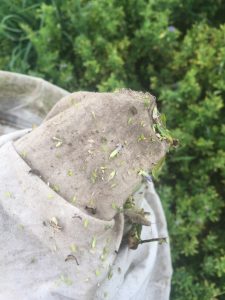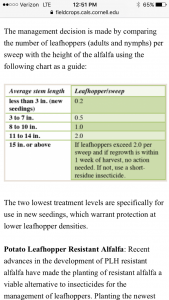Once the corn had reached around the V3 stage, the push to get PSNT’s (Pre-Sidedress Nitrate Test) done for our farms was on and I spent the majority of my days pulling samples. For the sample you take multiple 12” cores from all over the field to get a representative sample to use for nitrogen recommendations. Due to the very wet growing season we’ve had, a lot of corn is light green to yellow (an indicator for N deficiency) especially in the lower spots, which triggered a lot of our farmers to request these PSNT’s. Once the samples were pulled it was imperative that we kept them cool and got them back to the lab as soon as possible to make sure the sample and recommendation was as accurate as possible.
While the sampling and scouting was taking place, the alfalfa was growing back after first cutting and we began to notice the problem of the Potato Leaf Hopper. The Potato Leaf Hopper is a pest that normally feeds on the vegetative part of the potato plant, hence its name, however due to the lack of potatoes grown in New York it tends to feed on alfalfa instead. If the damage is intensive, the alfalfa plant turns a yellow to brown color and becomes necrotic. These pests can wipe out a pure alfalfa stand in a matter of days, depending on the height of the plant. The reason for this major outbreak of the Potato Leaf Hoppers is because of the great number storms that have moved their way up from the south and dumped rain on us all season. These small green pests are carried by the winds of the storm and end up here when the storm dissipates. Then when we get a few hot dry days after the storm, they reproduce like crazy and the problem starts.
We scouted the Potato Leaf Hoppers with sweep nets; generally doing 20 sweeps total throughout the entire field to get a good idea of the overall pest pressure. Then a decision would be made based on how many Potato Leaf Hoppers we found and the maturity of the alfalfa; using the Cornell guidelines as a reference. If we found that the pressure of the Leaf Hoppers was enough to call for some sort of action to be taken we would advise the farm to spray their alfalfa or mow it if it was close enough to harvest time.
After we got our PSNT’s taken care of and the Potato Leaf Hopper under control, the scouting continued with a focus on fungi and blight.


